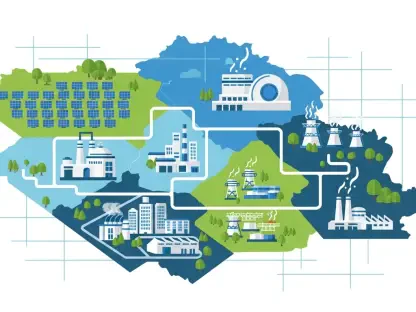In a world heavily reliant on energy, crude oil remains the lifeblood of global economies, fueling industries, transportation, and daily life, yet its price volatility continues to create uncertainty for markets worldwide with recent fluctuations driven by geopolitical tensions like the Russia-Ukraine conflict. As of 2025, the mere whisper of peace talks between these two nations has sent ripples through the oil market, raising a critical question: could a resolution to this long-standing war bring down crude oil prices significantly? This report dives into the intricate web of geopolitics, supply-demand dynamics, and regulatory forces shaping the industry, exploring whether diplomatic breakthroughs might offer relief at the pump or if other factors could keep prices stubbornly high.
Overview of the Global Crude Oil Market
The crude oil industry stands as a cornerstone of global economic stability, powering everything from manufacturing to personal mobility, with daily consumption hovering around 100 million barrels. Its influence permeates every sector, making price swings a matter of international concern, especially for energy-dependent nations. The market’s complexity arises from interconnected segments, including upstream exploration and production, as well as downstream refining and distribution, each sensitive to disruptions whether natural or man-made.
Key players like OPEC+, a coalition of oil-producing countries, alongside major US producers, dominate supply decisions that directly impact pricing. Geopolitical events often overshadow even the most calculated production strategies, as conflicts or sanctions can slash supply lines overnight, driving prices upward. With the Russia-Ukraine war still casting a long shadow, the market remains on edge, reacting to every headline about potential peace or escalated tensions.
Beyond traditional actors, emerging technologies and renewable energy transitions add layers of uncertainty to long-term demand forecasts. While oil remains king for now, the push for sustainability challenges its dominance, though immediate price movements are more tied to current events than future trends. This delicate balance of power, politics, and progress defines the industry’s present state, setting the stage for analyzing specific geopolitical impacts.
Geopolitical Impact on Oil Prices
Russia-Ukraine Conflict and Peace Prospects
Since erupting, the Russia-Ukraine war has severely disrupted global oil supply chains, with sanctions on Russian exports slashing availability and sending prices soaring at times. Russia, a major oil producer, faced export restrictions that tightened markets, particularly in Europe, which relied heavily on its crude. The resulting scarcity fueled volatility, with prices often spiking on fears of prolonged conflict.
Recent developments hint at a potential turning point, as discussions of peace talks, possibly involving high-profile figures like President Trump and President Putin, gain traction. If successful, a resolution could ease sanctions, allowing Russian oil to flow more freely into global markets. Such an influx might create downward pressure on prices, offering relief to consumers and industries burdened by high energy costs.
However, skepticism remains about the feasibility of a lasting agreement, given deep-seated animosities and complex international interests at play. Even if talks progress, the timeline for reintegrating Russian supply could lag, tempering immediate market reactions. The possibility of peace, while promising, is just one piece of a larger puzzle influencing oil valuations.
Sanctions, Tariffs, and Market Reactions
Compounding the geopolitical landscape are punitive measures like doubled US tariffs on nations purchasing Russian crude, now at 50%, aimed at curbing indirect support for Moscow. The European Union has also intensified its stance, imposing sanctions on Russian oil entities and severing financial ties by excluding key banks from the SWIFT system. These actions constrict supply routes, sustaining upward pressure on prices despite potential peace prospects.
On the flip side, if diplomatic efforts bear fruit, the market could see a counterforce with increased Russian exports challenging the constraints of sanctions. This tug-of-war between restrictive policies and potential supply boosts creates significant volatility, leaving traders and analysts guessing about short-term price directions. Each policy shift or tariff hike introduces fresh uncertainty into an already jittery market.
The interplay of these forces reveals a fragmented outlook where sanctions might offset any gains from peace talks, especially if enforcement tightens further. Market reactions often hinge on the perceived longevity of such measures versus the tangible outcomes of negotiations. This dynamic underscores the unpredictable nature of geopolitically driven price movements in the oil sector.
Supply and Demand Dynamics in the Oil Market
OPEC+ Production Strategies
OPEC+ has recently taken steps to bolster supply, announcing a production increase of 547,000 barrels per day starting this year, with a broader goal to restore 2.2 million barrels per day by 2027. This decision reflects a strategic response to stabilize markets amid fluctuating demand signals globally. Yet, the coalition remains vigilant, ready to tweak output if economic slowdowns dampen consumption.
Caution defines OPEC+’s approach, as oversupply risks loom large, especially with warnings from the International Energy Agency about a potential surplus equivalent to 1.5% of global consumption in the near term. Such a scenario could depress prices further if production outpaces demand recovery. The organization’s balancing act is critical to avoiding a glut while ensuring member nations maintain revenue streams.
This strategy also considers external pressures like competing production from non-OPEC countries, which could undermine pricing power. With global energy needs in flux, OPEC+ must navigate a tightrope, adjusting to real-time data while anticipating geopolitical resolutions that might flood the market with additional crude. Their decisions will play a pivotal role in shaping price trends over the coming months.
US Market Indicators and Global Inventories
Turning to the US, market data paints a mixed picture, with crude inventories sitting 6.5% below the five-year average, signaling tighter domestic supply conditions. Distillate stocks are even more strained at 16.1% below average, hinting at potential shortages in key refined products. Despite this, US production holds strong near record levels at 13.284 million barrels per day, though a slight dip suggests peaking capacity.
Globally, inventory trends add another layer of complexity, with crude stored on tankers dropping 15% week-over-week to 79.12 million barrels, often viewed as a bullish sign indicating reduced floating storage. However, this must be weighed against declining US drilling activity, with active oil rigs at a 3.75-year low of 410, reflecting a cautious approach by producers amid uncertain profitability. Such indicators suggest a market caught between supply tightness and operational restraint.
These contrasting signals complicate price forecasts, as low inventories could support higher prices while reduced drilling and storage shifts might ease upward momentum. The global picture remains fragmented, with regional disparities in stock levels and production rates influencing how price pressures manifest. Stakeholders must parse this data carefully to anticipate directional shifts in the market.
Challenges Facing the Crude Oil Market
Navigating the crude oil market in 2025 presents a maze of challenges, starting with the delicate balance of supply and demand amid persistent geopolitical uncertainty. Conflicts and diplomatic developments can alter supply landscapes overnight, while economic fluctuations impact consumption patterns, leaving producers and policymakers in a constant state of adjustment. This unpredictability tests the resilience of market mechanisms designed to stabilize prices.
Further complicating matters is OPEC’s limited spare capacity, which restricts the ability to offset sudden supply shocks, such as those potentially triggered by escalated tariffs on Russian oil. A supply disruption in this context could spike prices, especially with US drilling activity waning, as evidenced by the lowest rig count in nearly four years. This reduction signals a hesitancy to invest in new production under current market conditions.
Additionally, global economic headwinds, including inflationary pressures and varying recovery rates across regions, muddy demand projections. If major economies slow, oil consumption could drop, exacerbating oversupply risks already flagged by industry watchdogs. These intertwined issues create a precarious environment where missteps in policy or production could lead to significant price swings, challenging all market participants.
Regulatory and Policy Influences on Oil Pricing
Government policies wield immense power over oil pricing, with US and EU measures like tariffs and sanctions directly targeting Russian crude flows. The recent doubling of US tariffs on countries buying Russian oil, alongside EU blacklisting of related entities, constricts global supply channels, often inflating prices as alternative sources struggle to fill gaps. These actions aim to pressure Moscow but ripple through markets worldwide.
Financial restrictions, such as excluding Russian banks from the SWIFT network, further disrupt trade logistics, complicating payment mechanisms for oil transactions. Compliance with these stringent rules reshapes trade patterns, sometimes forcing buyers to seek costlier or less accessible supplies, which can sustain elevated price levels. The regulatory landscape thus acts as both a constraint and a driver of market behavior.
Currency dynamics also play a subtle yet significant role, with a strong US dollar making oil pricier for holders of other currencies, potentially dampening demand in non-dollar economies. This interplay of policy and economic factors creates a feedback loop, where regulatory decisions influence trade, which in turn affects pricing stability. Understanding these connections is vital for predicting how oil markets might evolve under shifting political priorities.
Future Outlook for Crude Oil Prices
Looking ahead, the trajectory of crude oil prices hinges on multiple variables, with the outcome of Russia-Ukraine peace talks standing as a potential game-changer. A successful resolution could unlock Russian supply, pushing prices downward as markets absorb the additional barrels, especially if sanctions are lifted progressively. However, failure to reach an accord might perpetuate supply constraints, keeping prices buoyant or even driving them higher.
OPEC+ production adjustments will also shape this outlook, with planned increases potentially leading to oversupply if global demand falters. The International Energy Agency’s caution about a surplus in the near term adds weight to bearish scenarios, though sudden geopolitical setbacks or tightened sanctions could flip the script, sparking price spikes. These opposing forces create a wide range of possible outcomes for market watchers to consider.
Emerging risks, such as policy-driven supply shocks or unexpected economic downturns, further cloud the horizon. If tariffs escalate to triple-digit levels or new conflicts arise, the market could face abrupt tightness. Conversely, sustained diplomatic progress and steady production growth might stabilize or lower prices over time. Monitoring these developments will be crucial for anticipating the next major shift in oil valuations.
Conclusion: Balancing Risks and Opportunities in Oil Markets
Reflecting on the analysis, it becomes clear that crude oil prices face downward pressure from the prospect of Russia-Ukraine peace talks and OPEC+ output hikes, yet linger under the threat of sanctions and supply constraints that could counteract these effects. The intricate dance of geopolitics and market dynamics leaves the industry in a volatile state, where each policy move or diplomatic signal carries weight. This delicate balance underscores the unpredictable nature of energy markets during this period.
Moving forward, stakeholders need to prioritize agility, closely tracking geopolitical resolutions and regulatory shifts to adapt strategies swiftly. Developing contingency plans for both oversupply and sudden shortages emerges as a practical step, ensuring resilience against price swings. Additionally, investing in data analytics to better predict demand trends offers a way to navigate economic uncertainties that influence consumption.
Ultimately, collaboration among producers, policymakers, and industry leaders stands out as essential to mitigate risks and seize opportunities in this fluctuating landscape. By fostering dialogue on sustainable production levels and sanction impacts, the sector can work toward greater stability. These actionable measures provide a pathway to address the challenges uncovered, guiding the market through its next phase of evolution.









